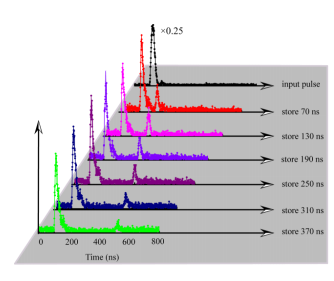First Quantum Memory That Records The Shape of a Single Photon Unveiled in China
Photons are the workhorses of modern communication. At present, they generally carry information in light pulses consisting of many photons but physicists are already able to use single photons instead, encoding data in their very structure.

One way of doing this is to use the photon’s orbital angular momentum, a measure of its helicity. So instead of travelling as an ordinary flat wave, the photon can be thought of as a helix with left or right handedness that is twisted to varying degrees.
Physicists can use this handedness and the amount of twist to encode data in the very shape and structure of the photon itself. This has big advantages over the way physicists exploit photons today.
The conventional way physicists do this is using polarisation. A photon can have two distinct polarisation states–either horizontal or vertical. It’s straightforward to create photons in one state or the other and use this to encode data.
The big advantage of orbital angular momentum is that a photon can be produced in an infinite number of different states of handedness and twistedness. That means a single photon can carry an arbitrarily large amount of information, in principle a least.
So it’s no surprise that researchers are eagerly exploring ways of creating and detecting photons with varying spatial structures that can carry information.
But what they’ve lacked is a way of storing these photons–including their detailed shape and structure–and then releasing them again later.
Today, Dong-Sheng Ding and pals at the University of Science and Technology of China in Hefei say they’ve cracked this problem for the first time.
These guys have generated a single photon with a complex spatial structure, stored that photon in a cloud of rubidium atoms and then released it up to 400 nanoseconds later. In their experiment, they compare the structure of the photons that come out of storage with the structure of the photons that go in and say they are more or less identical. “The spatial structure of the photon is preserved very well,” they say.
That’s a potentially important advance. Other groups have made similar attempts to store photons in this way but only by using laser beams so weak that they probably contain a single photon at any instant. However, there’s no way of being certain that the experiments definitely do involve single photons.
Dong-Sheng and co improve on this by creating their photons individually, using a process known as spontaneous four wave mixing. This means they can be sure the experiments involve single photons rather than an ensemble of them. “We report on the first experimental realization of storing a true single photon carrying an orbital angular momentum in a cold atomic ensemble,” they say.
The ability to store and release single photons is one of the enabling technologies for a quantum internet. These quantum storage devices are the key to quantum routers. Clearly, memories that can preserve the spatial structure of the photons will make this kind of router, and the internet it empowers, far more flexible and capable.
Of course, the technologies that end up making the quantum internet of the future will depend on many other factors, not least of which will be a significant dollop of luck. But given the numerous advances in this area made by Chinese labs in recent years, only a fool would bet against Chinese technology playing a significant role in the way we quantum communicate in future.
Ref: http://arxiv.org/abs/1305.2675: Single-Photon-Level Quantum Image Memory Based on Cold Atomic Ensembles
Keep Reading
Most Popular
Large language models can do jaw-dropping things. But nobody knows exactly why.
And that's a problem. Figuring it out is one of the biggest scientific puzzles of our time and a crucial step towards controlling more powerful future models.
The problem with plug-in hybrids? Their drivers.
Plug-in hybrids are often sold as a transition to EVs, but new data from Europe shows we’re still underestimating the emissions they produce.
Google DeepMind’s new generative model makes Super Mario–like games from scratch
Genie learns how to control games by watching hours and hours of video. It could help train next-gen robots too.
How scientists traced a mysterious covid case back to six toilets
When wastewater surveillance turns into a hunt for a single infected individual, the ethics get tricky.
Stay connected
Get the latest updates from
MIT Technology Review
Discover special offers, top stories, upcoming events, and more.